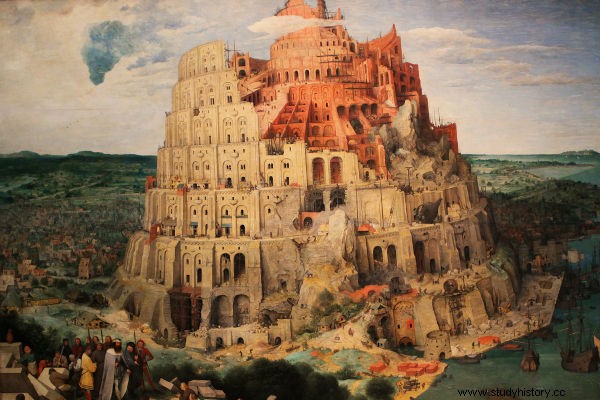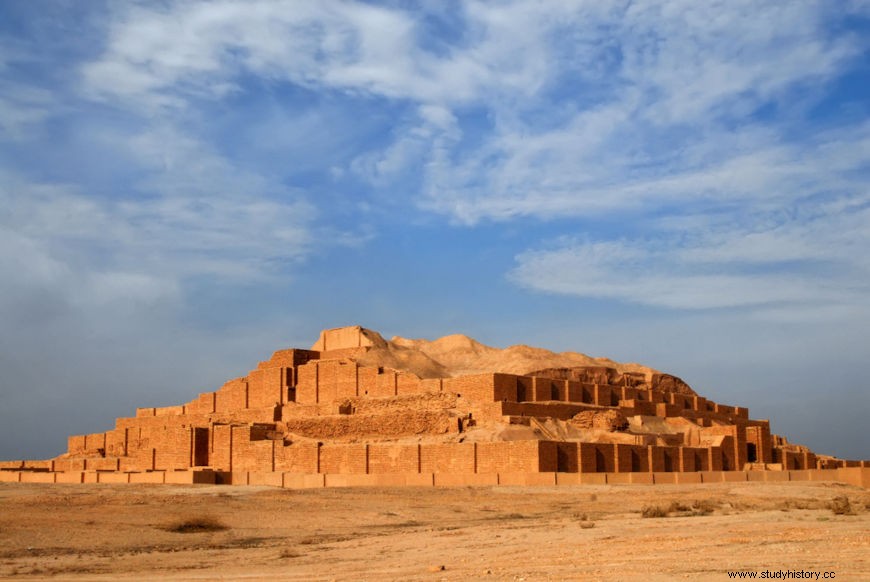
Tower of Babel is a well-known myth narrated in the Bible which tells the episode in which the people of a city decided to build a tower that would reach the heavens. In the myth, God intervened in the situation, causing confusion in humanity by creating different languages. Historians believe that this story may have its origins in Mesopotamia and that the tower in question is a ziggurat that was built in Babylonia.
Go to also :Babylonian Captivity—The Enslavement of the Hebrew People
Tour of Babel Summary
- Tower of Babel is a biblical myth that tells of the construction of a tower that would reach the heavens.
- God would have caused confusion in humanity by establishing different languages, which prevented the tower from being built.
- This myth is found in Genesis 11:1-9.
- Historians believe that the Tower of Babel may correspond to a ziggurat that was built in Babylon.
- There is a Sumerian myth that narrates a similar episode called “Enmercar and the Lord of Arata”.
Myth of the Tower of Babel
Tower of Babel is a biblical myth narrated in the book of Genesis that tells the story of the emergence of the different languages spoken by human beings . From the content of the narrated story, historians understand that the Tower of Babel is a founding myth, as it traces an origin to the diversity of human language and the spread of human beings across the planet.
The myth of the Tower of Babel tells that after the deluge (another narrative present in the Bible), a group of people settled in a certain place, deciding to create a city there and carry out the building a tower that would reach the sky . The purpose of this construction would be to prevent people from scattering and make the tower famous.
However, God came down from heaven to observe the city and, realizing what had happened, decided to intervene in the situation. He decided to create great confusion in mankind by creating different languages . The emergence of different languages caused the construction to be interrupted, as humans no longer understood each other. Thus, humanity dispersed.
This myth can be found in Genesis 11:1-9 . Let's look at the biblical narrative:
- In the whole world there was only one language, only one way of speaking.
- As the men left the East, they found a plain at Shinar and settled there.
- They said to each other, "Let's make bricks and burn them well." They used bricks instead of stones and pitch instead of mortar.
- Then they said, “Let's build a city, with a tower that reaches the heavens. Then our name will be famous and we will not be scattered over the face of the Earth.”
- The Lord came down to see the city and the tower that men were building.
- And the Lord said, “They are one people, and they speak one language, and they began to build it. Soon, nothing will be able to stop what they plan to do.
- Come, let's go down and confuse the language they speak, so they don't understand each other anymore.”
- So the Lord scattered them from there throughout the earth, and they stopped building the city.
- That is why it was called Babel, because there the Lord confused the language of the whole world. From there the Lord scattered them over the whole earth.|1|
Learn more: Code of Hammurabi — the code of laws drawn up in the reign of the Babylonian Hammurabi
Tower of Babel in History
The context presented allowed scholars to claim that this myth narrates supposed events that took place in Mesopotamia. However, it is important to consider thathistorians do not consider the accounts of the book of Genesis to be historical accounts . The narratives of this biblical book are understood as myths that help us understand particularities of the Hebrew culture.

Not much is known about her, but there are historians who speculate that the Tower of Babel would have been the Etemenanki , a ziggurat (a type of temple extremely popular throughout Mesopotamia) that was built and dedicated to Marduk in the city of Babylon. In Mesopotamia, Marduk was known as the god responsible for creation and considered the patron of Babylon.
Historians believe that Etemenanki may have been built in the 2nd millennium BC It was very common for ziggurats to have a temple in honor of some god. The ziggurats were created by the Sumerians, but they became popular among other peoples of Mesopotamia.
The connection of these constructions with religion led historian Paul Kriwaczek to state that the ziggurats sought to “allow the human and divine scales to touch momentarily”.|2 |
Paul Kriwaczek also presents other reasons that are speculated by historians as possible causes that explain the construction of the ziggurats:
Since the Mesopotamian ziggurats were unearthed, scholars have debated their exact purpose:perhaps to represent the sacred mountain of the Sumerians' supposed original homeland; perhaps elevating the god's sanctuary above the floods that regularly afflicted southern Mesopotamia; possibly keep the common people as far away from the high sanctuary as possible.|3|
Professor John H. Walton claims that the ziggurats could be a temple that served as an abode for some deity . He also claims that the ziggurat could play a role in Mesopotamian cosmology as a place of connection between heaven and Earth. He concludes, however, that these theories lack substantiation.|4|
The biblical narrative states that this tower (or ziggurat) was named after Babel, a word that would have meant “confusion”. However, the origin of this term is unknown to historians.
Finally, it is important to mention that there is a Sumerian myth that narrates an event similar to the biblical myth . This myth is called "Enmercar and the Lord of Arata", and it mentions an episode in which the god Enki would have created confusion among men by changing the language they spoke.
Notes
|1| Online Bible. Genesis 11. To access, click here.
|2| KRIWACZEK, Paul. Babylon:Mesopotamia and the Birth of Civilization. Rio de Janeiro:Zahar, 2018, p. 199.
|3| Ditto, p. 200.
|4| WALTON, John H. The Mesopotamian Background of the Tower of Babel Account and Its Implications. To access, click here [in English].
